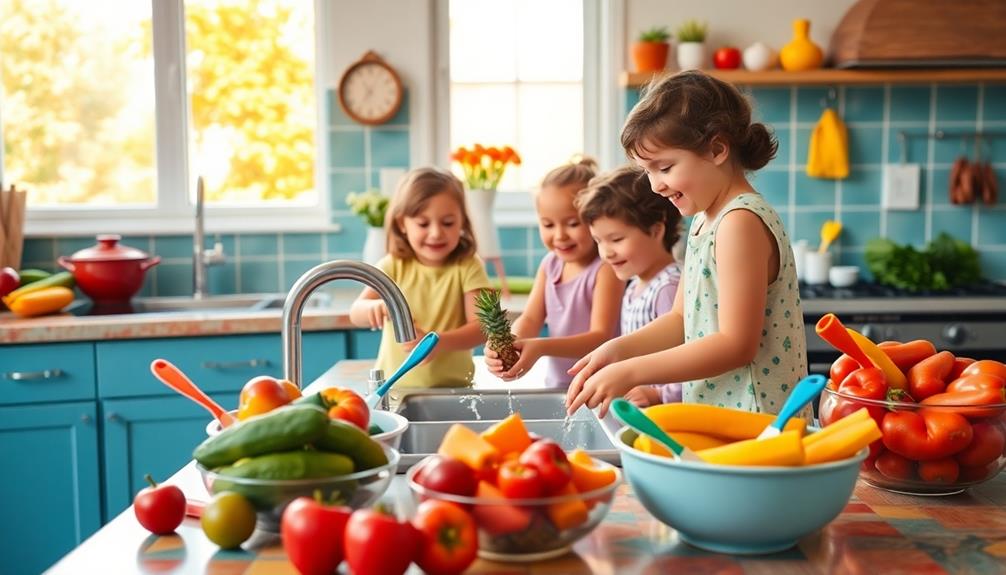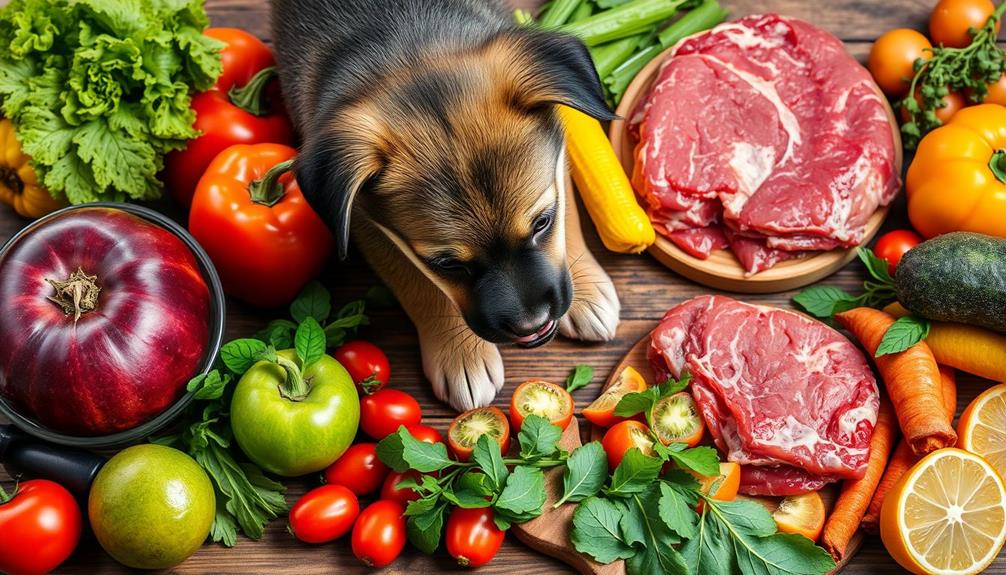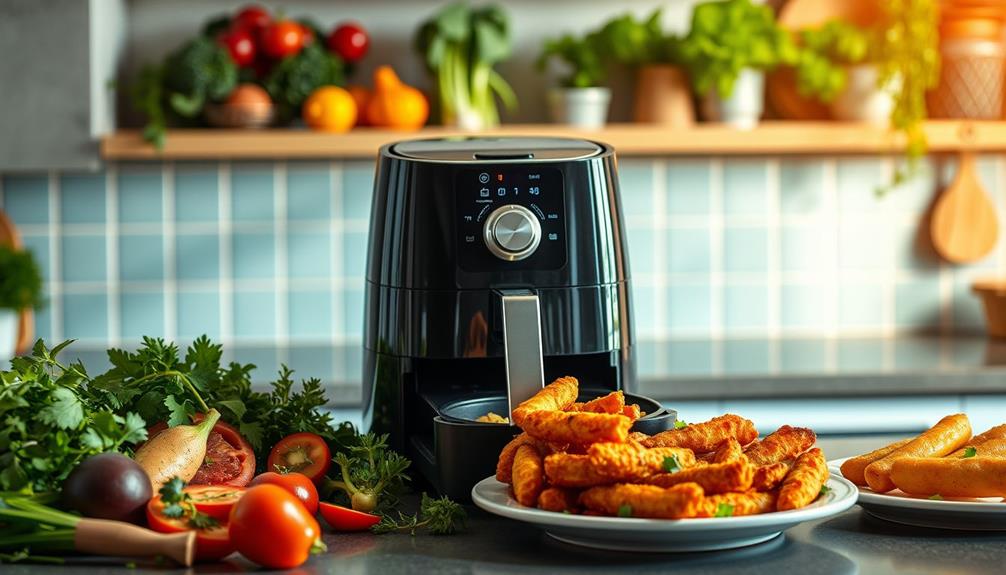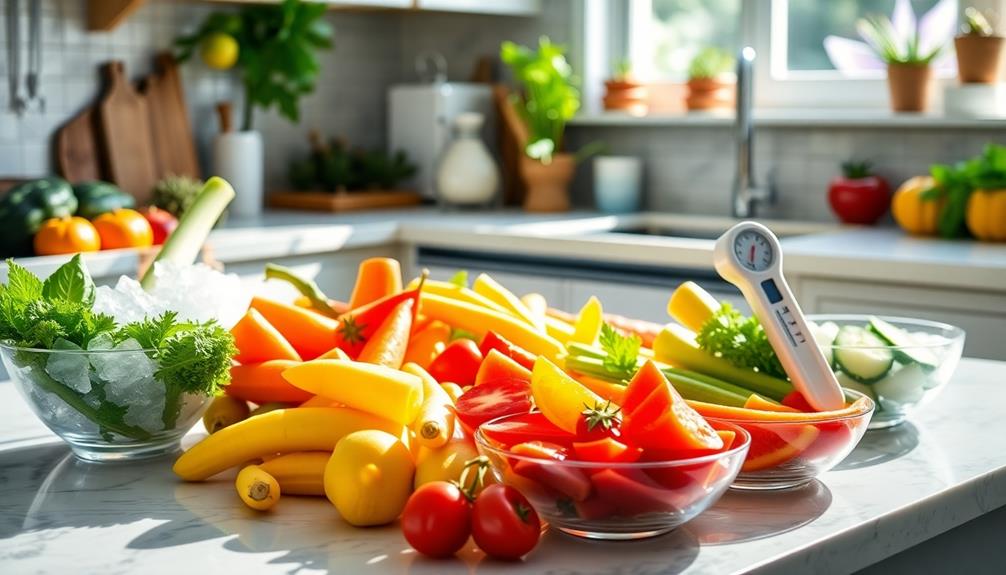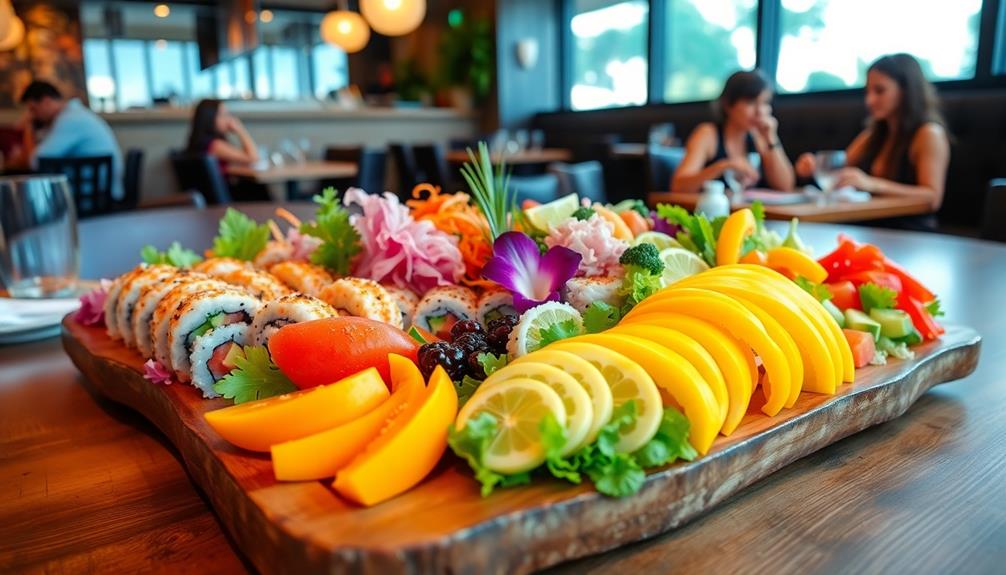When preparing raw food for children, focus on safety to protect against harmful bacteria and allergens. Start by washing your hands before and after handling food. Always rinse fruits and veggies under running water to remove contaminants. Keep raw foods separate from ready-to-eat items to avoid cross-contamination. Use clean surfaces and tools, and supervise your child closely during food prep to teach them safe cutting techniques. Be aware of food allergies and introduce new foods gradually. These simple steps guarantee a safer kitchen environment and healthy eating habits—keep exploring to discover more essential tips and practices!
Key Takeaways
- Always wash hands with soap before and after handling raw foods to prevent foodborne illnesses.
- Rinse all fruits and vegetables under running water to eliminate pesticides and contaminants.
- Keep raw foods separate from ready-to-eat foods to avoid cross-contamination.
- Supervise children closely when using sharp tools and teach proper cutting techniques for safety.
- Be aware of food allergies and educate children about their specific dietary restrictions to ensure safety.
Importance of Food Safety
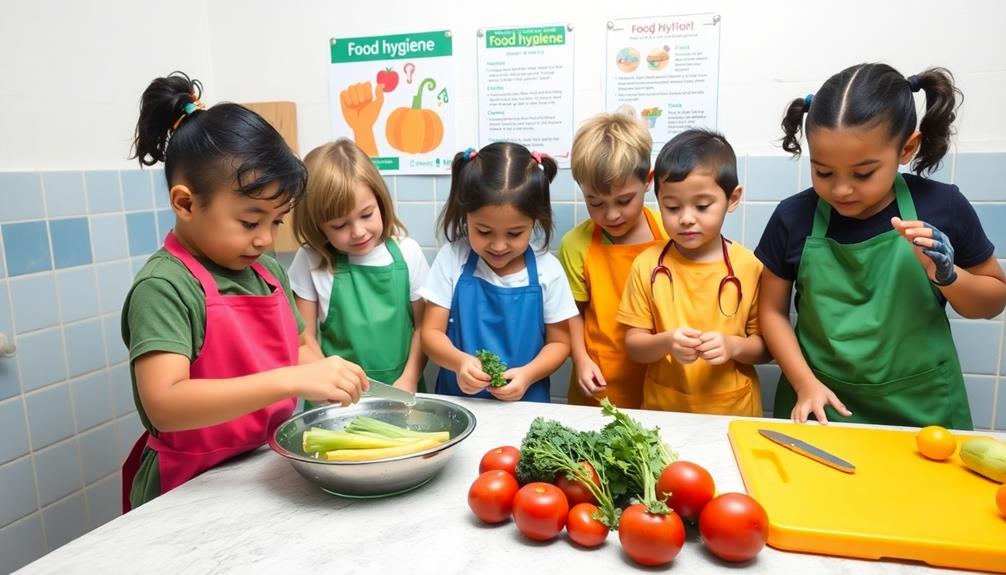
Food safety is fundamental, especially when it comes to preparing raw foods for children. Kids are more vulnerable to harmful bacteria found in raw foods, making it essential to take every precaution. One of the simplest steps you can take is to wash your hands with soap before and after handling any food, particularly raw items. This helps greatly reduce the risk of cross-contamination.
When you're preparing raw fruits and vegetables, remember to wash them thoroughly under running water. This removes pesticides and potential pathogens that could harm your child's health.
It's also important to keep raw food items, especially meats, separate from ready-to-eat foods in your refrigerator. This separation prevents cross-contamination that can lead to foodborne illnesses.
Additionally, make sure that all utensils and surfaces you use are cleaned and sanitized. This step eliminates any lingering bacteria that could pose a risk.
By prioritizing food safety in these ways, you're not just protecting your children; you're also creating an environment where they can enjoy healthy meals without the worry of foodborne illnesses.
Preventing Foodborne Illness
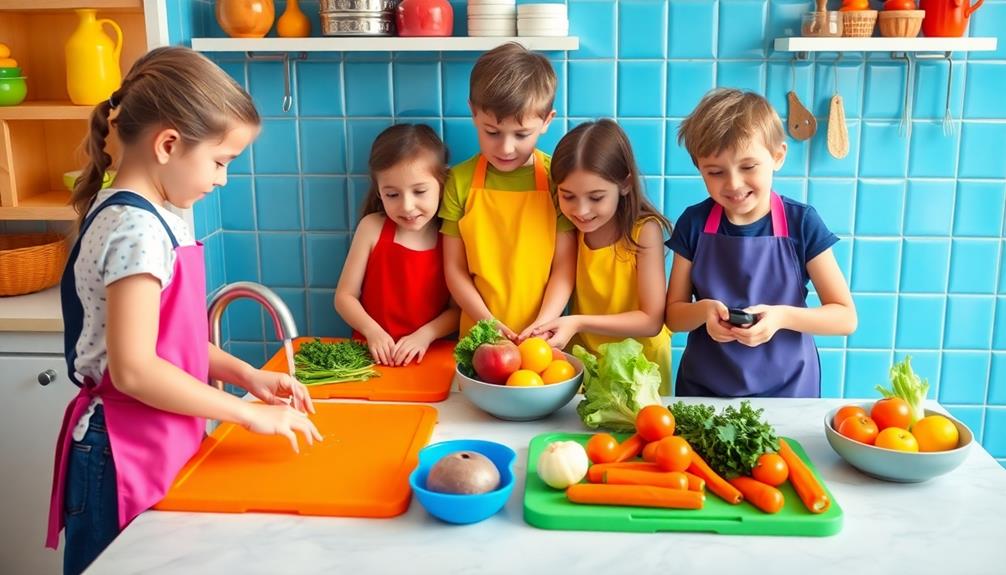
When it comes to preventing foodborne illness in children, proper handwashing and safe food handling are key.
You should always wash your hands before preparing food and after touching raw ingredients to stop bacteria from spreading.
Keeping your kitchen surfaces clean and monitoring for any signs of illness can help keep your little ones safe.
Handwashing Importance
Handwashing stands as an essential line of defense against foodborne illnesses, especially for young children who are more susceptible to harmful bacteria. By practicing proper handwashing, you greatly reduce the risk of contamination during food preparation.
Make it a habit to wash your hands before you start cooking and after handling raw foods. This practice is particularly important as children often form deep emotional bonds with their surroundings, making them more vulnerable to neglecting hygiene when engrossed in play or activities, which can lead to increased health risks.
Additionally, frequent absences in parental supervision can exacerbate these risks, highlighting the need for consistent and engaged parenting in fostering safe habits trust issues with boyfriend no-shows.
To help instill the importance of handwashing in your children, remind them to wash their hands:
- After playing with pets, as they can carry bacteria.
- Before eating, to guarantee their hands are clean.
- After using the bathroom, to prevent the spread of germs.
It's essential to make sure that your child's hands are clean before meals to protect against foodborne illnesses. Teaching them these habits not only helps them stay safe but also fosters a sense of responsibility about hygiene.
Additionally, keeping food preparation surfaces clean and away from pets further supports a safe environment for food handling. Emphasizing the handwashing importance in your daily routine can make a considerable difference in your child's health and well-being, creating a safer space for their meals.
Safe Food Handling
Safe food handling is vital for protecting your family from foodborne illnesses, especially children who are more vulnerable to harmful bacteria. Always wash your hands thoroughly with soap and water before and after handling raw foods. This simple step markedly reduces the risk of spreading harmful germs.
When preparing meals, keep raw foods, particularly meats and eggs, separate from ready-to-eat foods. This practice prevents cross-contamination, which can lead to serious health issues. After using surfaces and utensils for raw foods, clean them with hot, soapy water to eliminate any lingering bacteria.
You should also verify that fruits and vegetables are washed under plain running water before consumption. This step removes dirt and potential contaminants that could harm your child.
Additionally, it's imperative to store raw foods at appropriate temperatures. Set your refrigerator to 40°F (5°C) and keep your freezer at 0°F (-18°C) to inhibit bacterial growth effectively.
Safe Food Storage Practices
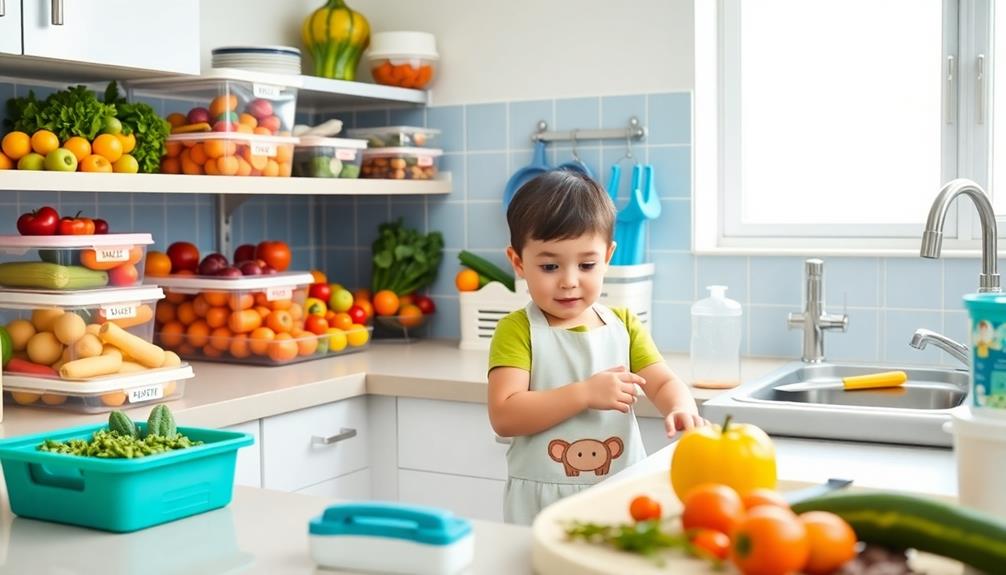
To keep your child's food safe, proper storage practices are vital. When handling raw food, it's important to cool cooked dishes within 1-2 hours and refrigerate or freeze them immediately. Rice should be cooled within an hour and consumed within 24 hours to minimize bacterial growth.
Here are some key points to take into account:
- Store leftovers properly: Reheat them until steaming hot, but let them cool down to lukewarm before serving to your child.
- Handle eggs safely: Keep them in their original carton on a fridge shelf to maintain quality.
- Monitor storage times: Unopened hot dogs and deli meats can last up to two weeks, while opened varieties should be consumed within a week or 3-5 days, respectively.
Always verify your refrigerator is at or below 40°F (5°C) and your freezer at 0°F (-18°C) to keep food safe.
Safe Food Preparation Techniques

When you're preparing raw food for your kids, it's vital to focus on essential washing practices and proper cutting techniques.
Start by washing your hands and all surfaces thoroughly to eliminate bacteria.
Then, make sure to rinse fruits and vegetables under running water and use clean cutting tools to keep everything safe and healthy.
Essential Washing Practices
Many parents mightn't realize how vital it's to wash fruits and vegetables thoroughly before preparing them for children. Proper washing can greatly reduce the risk of exposing your little ones to harmful bacteria and dirt.
Here are some key practices to follow:
- Always wash all fruits and vegetables under plain running water to effectively remove surface dirt and bacteria.
- For firm produce like potatoes and cucumbers, use a clean brush to scrub away contaminants.
- Before washing, remove any damaged or bruised parts to prevent bacteria from spreading.
When dealing with melons, don't forget to wash the outer skin before cutting. This simple step helps avoid transferring bacteria from the surface to the flesh.
After washing, it's essential to dry your produce with a clean towel or paper towel to minimize moisture that can promote bacterial growth.
Proper Cutting Techniques
Ensuring your child's safety during food preparation starts with proper cutting techniques. Always teach your child to keep blades pointed away from their body while cutting food. This simple rule minimizes the risk of injury and promotes safe habits.
Use a stable cutting board to prevent slipping, which can lead to accidents while cutting. Additionally, introducing hands-on learning through engaging activities can help children understand the importance of safety in the kitchen.
Supervise your child closely when they're using sharp tools, as their maturity levels can vary greatly. It's essential to foster a safe environment. Teach them proper hand positioning by demonstrating the "claw grip." This technique keeps fingers safely away from the blade, allowing for more controlled cutting.
Start with age-appropriate cutting utensils, like plastic knives for younger children. These options can help them build confidence and skills without the risk of serious injury.
As they become more proficient, you can gradually introduce sharper tools, always emphasizing safety.
Understanding Food Allergies
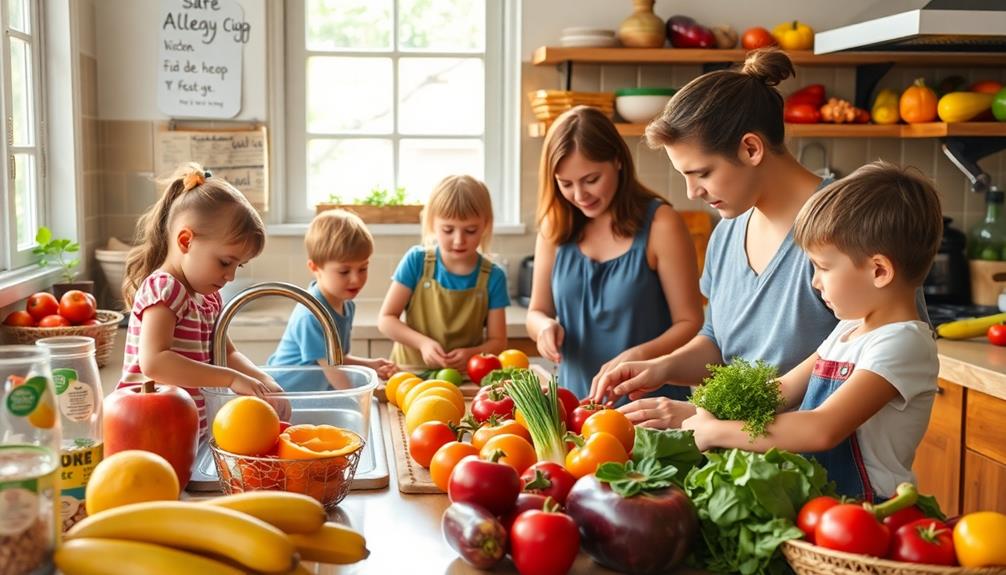
Food allergies in children can pose significant challenges for parents, making it essential to identify and avoid potential triggers. Common allergens include peanuts, tree nuts, eggs, milk, wheat, soy, fish, and shellfish.
When preparing food, especially if you're considering eating raw items, you must be extra vigilant. Understanding the emotional dynamics involved when caring for a child with allergies can be vital, as parents may experience heightened stress and anxiety during meal preparation and outings, similar to the challenges faced by those steering through divorce with a partner with BPD.
Here are some important considerations:
- Watch for signs: Hives, swelling, and difficulty breathing can signal an allergic reaction.
- Consult professionals: Speak with healthcare providers to manage allergies effectively.
- Early introduction: Introducing allergenic foods under guidance may lower the risk of developing allergies.
When preparing raw food, always check for the British Lion mark on hens' eggs, as they're safe for raw or lightly cooked use.
However, never serve raw or lightly cooked shellfish due to the high risk of allergens.
Feeding Practices and Nutrition

Nurturing healthy eating habits in children lays the foundation for their lifelong relationship with food. Start by introducing solid foods gradually, beginning with smooth, pureed options. This approach promotes acceptance and minimizes choking hazards.
To guarantee balanced nutrition, offer a variety of meal ideas that include fruits, vegetables, grains, and proteins. It's essential for kids to receive the vitamins they need for growth.
When handling raw meat, make sure you teach proper hygiene and safety practices. This includes washing hands before and after handling raw meat to prevent cross-contamination.
For hydration, use appropriate cups for young children, steering clear of sugary beverages. Instead, encourage water and milk as their primary drinks.
If your child shows fussy eating habits, don't get discouraged. Keep providing diverse food options. Repeated exposure can help them develop a taste for different foods.
Additionally, monitor portion sizes and adjust based on your child's appetite, so they don't feel overwhelmed. By establishing these feeding practices, you're setting the stage for your child's healthy eating habits and a positive relationship with food.
Cooking Together Benefits

Cooking together can be a joyful and rewarding experience for both you and your child. Not only does it foster teamwork, but it also enhances communication skills as you collaborate in the kitchen. Engaging in cooking activities helps your child develop a lifelong love for culinary arts, building confidence and self-sufficiency.
Here are some emotional benefits you'll cherish:
- Lasting memories: Each meal you prepare together becomes a treasured moment.
- Bonding time: The shared experience strengthens your relationship, creating a unique connection.
- Healthy habits: You instill an understanding of nutrition, encouraging better food choices for a healthier future.
Involving your child in cooking not only makes them excited about cooked food, but it also teaches safety techniques that reduce injury risks. As they learn to handle kitchen tools responsibly, they gain a sense of accountability.
These shared experiences cultivate a fun and interactive learning environment, making you both feel accomplished. So roll up your sleeves, and enjoy the journey of cooking together—it's an investment in your child's future and your relationship!
Frequently Asked Questions
How Do You Make Raw Food Safe To-Eat?
To make raw food safe to eat, wash all fruits and veggies thoroughly, scrub firm produce, remove damaged areas, and always clean your hands, utensils, and surfaces. Store raw and cooked items separately in the fridge.
What Are the 4 Safe Food Preparation Techniques?
To guarantee safe food preparation, you should wash all utensils, store raw meats separately, cook foods thoroughly, and wash fruits and vegetables before serving. These techniques help prevent contamination and keep meals safe to eat.
Can Children Eat Raw Food?
Yes, children can eat raw food like fruits and certain vegetables. Just make sure you wash them thoroughly and introduce new items gradually to monitor for any potential allergies or reactions.
What Precautions Should Be Taken Before Eating Raw Food?
Before eating raw food, you should wash your hands, rinse fruits and veggies under running water, use clean utensils, avoid cross-contamination, store items properly in the fridge, and watch for any allergic reactions.
Conclusion
In summary, keeping your kids safe while they enjoy raw foods is essential. By practicing proper food safety, storage, and preparation techniques, you can help prevent foodborne illnesses and keep allergies at bay. Plus, cooking together not only teaches valuable skills but also creates lasting memories. So, don't just throw caution to the wind—take these steps to make certain your little ones have a safe and delicious experience with raw foods!

